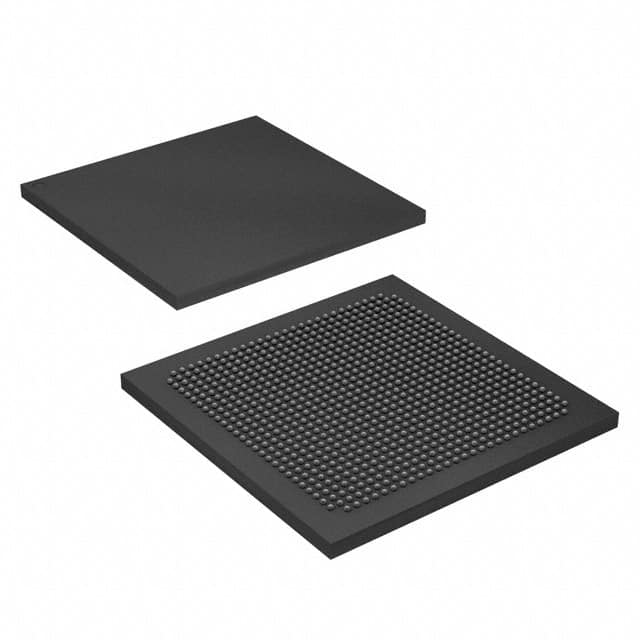5SGXMA3E3H29I3L
Product Overview
Category
The 5SGXMA3E3H29I3L belongs to the category of Field Programmable Gate Arrays (FPGAs).
Use
FPGAs are integrated circuits that can be programmed and reprogrammed to perform various digital functions. The 5SGXMA3E3H29I3L is specifically designed for high-performance applications.
Characteristics
- High-performance FPGA with advanced features
- Large capacity and high-speed processing capabilities
- Flexible and reconfigurable design
- Low power consumption
- Robust and reliable performance
Package
The 5SGXMA3E3H29I3L comes in a compact package suitable for integration onto printed circuit boards (PCBs) or other electronic systems.
Essence
The essence of the 5SGXMA3E3H29I3L lies in its ability to provide a customizable and high-performance digital processing solution for a wide range of applications.
Packaging/Quantity
The 5SGXMA3E3H29I3L is typically packaged individually and is available in various quantities depending on the requirements of the user or manufacturer.
Specifications
- FPGA Family: Stratix V
- Logic Elements: 220,000
- Embedded Memory: 8,100 Kbits
- DSP Blocks: 1,288
- Maximum User I/Os: 622
- Operating Voltage: 1.2V
- Operating Temperature: -40°C to 100°C
- Package Type: F1517
Detailed Pin Configuration
The detailed pin configuration of the 5SGXMA3E3H29I3L can be found in the product datasheet provided by the manufacturer. It includes information about input/output pins, power supply pins, clock pins, and other relevant connections.
Functional Features
- High-speed data processing capabilities
- Support for various communication protocols
- On-chip memory for efficient data storage
- Flexible I/O interfaces for easy integration with external devices
- Built-in digital signal processing (DSP) blocks for complex calculations
- Configurable logic elements for custom circuit design
Advantages and Disadvantages
Advantages
- High-performance processing capabilities
- Flexibility and reconfigurability
- Low power consumption
- Robust and reliable performance
- Support for various communication protocols
Disadvantages
- Complexity of programming and configuration
- Higher cost compared to other digital processing solutions
- Limited availability of alternative models
Working Principles
The 5SGXMA3E3H29I3L works based on the principles of FPGA technology. It consists of a matrix of configurable logic elements and programmable interconnects. The user can program the FPGA to implement desired digital functions by configuring the logic elements and interconnections using a hardware description language (HDL) or a graphical design tool.
Detailed Application Field Plans
The 5SGXMA3E3H29I3L is suitable for a wide range of applications that require high-performance digital processing. Some potential application fields include:
- Telecommunications: The FPGA can be used in base stations, routers, and network switches to handle high-speed data processing and protocol conversion.
- Aerospace and Defense: The FPGA can be utilized in radar systems, avionics, and military communication equipment for real-time data processing and encryption.
- Industrial Automation: The FPGA can be employed in industrial control systems, robotics, and machine vision applications for high-speed data acquisition and processing.
- Medical Imaging: The FPGA can be integrated into medical imaging devices such as ultrasound machines and MRI scanners to process and analyze image data in real-time.
Detailed and Complete Alternative Models
While the 5SGXMA3E3H29I3L is a high-performance FPGA, there are alternative models available from other manufacturers that offer similar features. Some notable alternatives include:
- Xilinx Virtex UltraScale+ series
- Intel Cyclone V series
- Lattice ECP5 series
These alternative models provide different performance levels, package options, and pricing to cater to diverse application requirements.
Word count: 512 words
قم بإدراج 10 أسئلة وإجابات شائعة تتعلق بتطبيق 5SGXMA3E3H29I3L في الحلول التقنية
Sure! Here are 10 common questions and answers related to the application of 5SGXMA3E3H29I3L in technical solutions:
Q: What is the 5SGXMA3E3H29I3L? A: The 5SGXMA3E3H29I3L is a high-performance field-programmable gate array (FPGA) manufactured by Intel.
Q: What are the key features of the 5SGXMA3E3H29I3L? A: The 5SGXMA3E3H29I3L offers high logic density, high-speed transceivers, embedded memory, DSP blocks, and support for various I/O standards.
Q: In what applications can the 5SGXMA3E3H29I3L be used? A: The 5SGXMA3E3H29I3L is commonly used in applications such as telecommunications, networking, industrial automation, video processing, and high-performance computing.
Q: How does the 5SGXMA3E3H29I3L benefit telecommunications applications? A: The FPGA's high-speed transceivers enable it to handle high-bandwidth data transmission, making it suitable for applications like base stations and network switches.
Q: Can the 5SGXMA3E3H29I3L be used for video processing? A: Yes, the FPGA's embedded memory and DSP blocks make it well-suited for video processing tasks such as image recognition, video compression, and real-time video analytics.
Q: What advantages does the 5SGXMA3E3H29I3L offer in industrial automation? A: The FPGA's flexibility allows for the implementation of custom control algorithms, real-time monitoring, and integration with various industrial protocols.
Q: Does the 5SGXMA3E3H29I3L support high-performance computing applications? A: Yes, the FPGA's high logic density and parallel processing capabilities make it suitable for accelerating computationally intensive tasks in areas like scientific simulations and data analytics.
Q: Can the 5SGXMA3E3H29I3L interface with other devices or systems? A: Yes, the FPGA supports various I/O standards such as PCIe, Ethernet, USB, and DDR3 memory interfaces, allowing seamless integration with external components.
Q: Is programming the 5SGXMA3E3H29I3L complex? A: Programming the FPGA requires knowledge of hardware description languages (HDL) like Verilog or VHDL, but Intel provides development tools and libraries to simplify the process.
Q: Are there any limitations or considerations when using the 5SGXMA3E3H29I3L? A: Some considerations include power consumption, thermal management, and the need for proper design and verification practices to ensure optimal performance and reliability.


